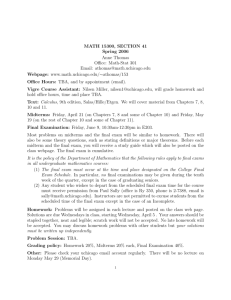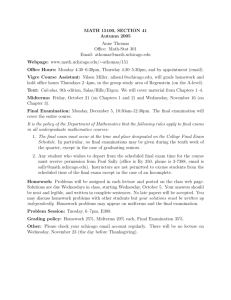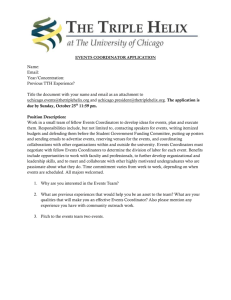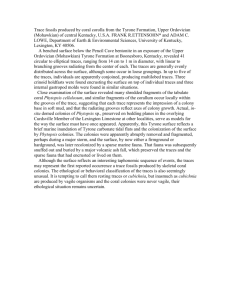The Epigraphic Survey
advertisement
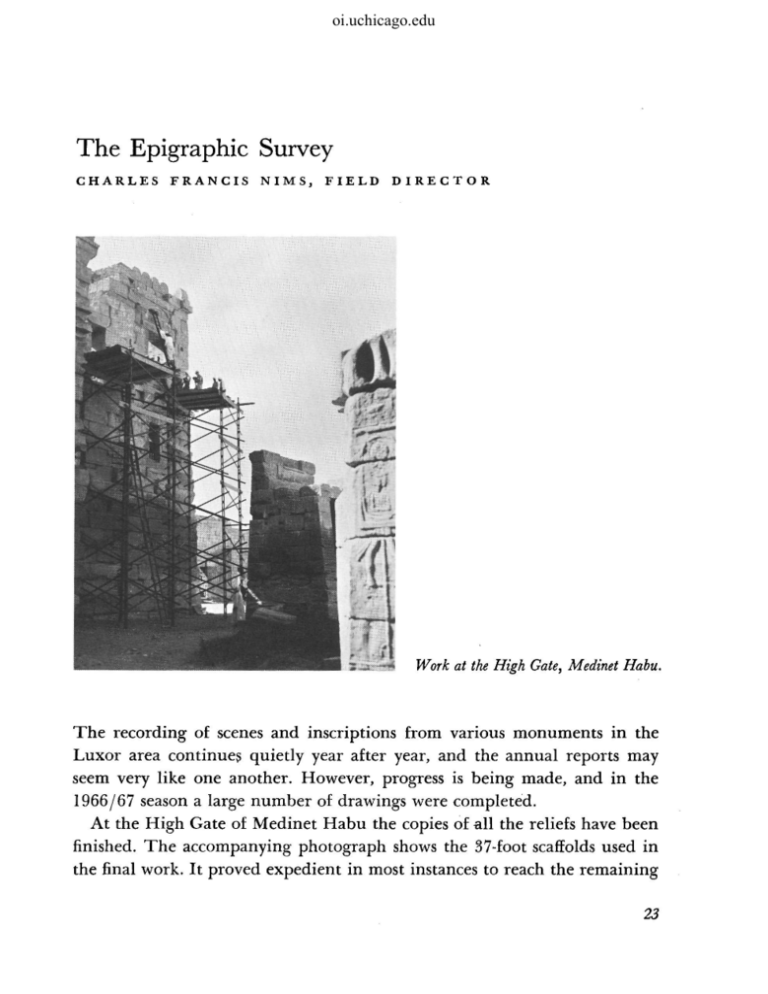
oi.uchicago.edu The Epigraphic Survey CHARLES FRANCIS NIMS, FIELD DIRECTOR Work at the High Gate, Medinet Habu. The recording of scenes and inscriptions from various monuments in the Luxor area continues quietly year after year, and the annual reports may seem very like one another. However, progress is being made, and in the 1966/67 season a large number of drawings were completed. At the High Gate of Medinet Habu the copies of all the reliefs have been finished. The accompanying photograph shows the 37-foot scaffolds used in the final work. It proved expedient in most instances to reach the remaining 23 oi.uchicago.edu 23 feet with ladders on top of the scaffolds rather than build these higher. W e must still consider the painted designs on the reveals of the windows; all this paint work is badly rubbed and faded. Provisionally, we have selected the two best-preserved examples and will work on these immediately on our return. T h e r e are several photographs of details and of over-all views yet to be taken. Work on the publication is already under way. One of the troubling problems in drawing the reliefs is the recarving of most of the figures of Ramses III. Long study has been made of these changes, b u t we have not always been able to satisfy ourselves as to what was the final version. T h e inscription accompanying one of the last scenes drawn tells that the girls shown in the harem scenes are the king's daughters. We had suspected this but had previously been unable to prove it. Another badly damaged scene proved, on careful study, to show a stringed trio of the princesses playing before their father, whom they address by his nickname, "Sesi." In the T o m b Chapel of Kheruef most of the scenes and inscriptions have been completed, though there are a few areas still needing further study. Among these are the over 170 fragments from the eight lines of vertical inscriptions originally on two pillars in the columned hall. These were photographed to a single scale, and through the studies of David Larkin, a graduate student of the Oriental Institute who was on the staff this season, a large n u m b e r of these were identified as to the lines to which they belonged. By using the photographs these fragments will be further studied this summer. O n the south wall of the entrance passage of this chapel the first scene shows Amenhotep IV, whose figure was anciently expunged, presenting a great offering to the god Re-Harakhti. Before the king and above the offerings is a squared-off panel, with thirteen by fourteen divisions. It had been anciently erased, we believe by the Amarna zealots. A few evident traces had led previous observers to believe that this was the usual table of offerings. When we began to study the traces, we were surprised to discover that instead it was a so-called "crossword puzzle," an inscription which was read both horizontally and vertically. T h i s is the earliest example known of this rare type of inscription. Because of the extensive damage we can never recover the 24 oi.uchicago.edu full content of this inscription, b u t our study of the remaining traces makes certain that we can restore accurately some considerable part. At the base of the walls of the passage are two prayers to Re and one to Osiris, also erased by the Amarna protagonists. Here we have followed the clues of the traces and through the study of many published and unpublished similar texts have been able to make out all but a few phrases. Each prayer will be published in two copies, one showing the traces we have discerned and the other the text as restored from our researches. Visiting scholars, who at first could make nothing out of these damaged areas, were convinced of the effectiveness of our epigraphic procedure. About the middle of December, 1966, we resumed our work on the T e m p l e of Khonsu, in Karnak, with attention given to the walls of the first hypostyle hall. Here the reliefs were made under the High Priest Herihor, who pictured himself presenting offerings to the gods in at least one scene in each of the six sections. He occupied the position heretofore taken by the king. H e tells us that the decoration of this room was done "at the instruction of Ramses X L " It was only in the last scenes carved in this hall, about the north doorway, that Herihor proclaimed himself king. T h e rough execution of the reliefs, in contrast to the carefully carved ones at Medinet Habu, presented new problems to both artists and epigraphers. O u r new artists, J o h n Romer and Grace Huxtable, were engaged in this endeavor. T h e former had just graduated from the Royal Academy of Art in London; the latter has had long experience as an illustrator and as an archeological draughtsman. T h e other members of the staff were the Field Director, Edward Wente, Carl DeVries, and David Larkin as Egyptologists, joined by J o h n Callender in January after his completion of the work of our expedition in the Sudan. Each of the permanent staff of Egyptologists always has several tasks. Wente has been Librarian for several years, keeping the library current with the new publications and searching the sales catalogues to fill gaps on the shelves. DeVries has assisted in photography and will have full responsibility for this in the coming season. Labib Habachi spent two months with us, continuing his study of the history of Kheruef and his T o m b Chapel. Reginald Coleman and Leslie Greener, veterans at Chicago House, completed the staff of artists. 25 oi.uchicago.edu Greener retired at the end of the academic year. His enthusiastic interest in the work of the expedition and in ancient Egypt in general, witnessed by his popular publications, has contributed much to Chicago House, and he will be greatly missed. J o h n Healey continued his efficient supervision of the plant, of which he has been in charge for thirty-five years. Myrtle Nims continued to serve as supervisor of the household, the traditional task of the wife of the Field Director. T h e r e were fewer guests from among the members and friends of the Oriental Institute during the season, in part because of the larger n u m b e r of staff and wives in residence. These averaged fifteen throughout the season. Even though we are not always able to accommodate guests, all who are interested in ancient Egypt are invited to visit us, to see our work and facilities, and to join us at tea. Members of the staff at Chicago House, Luxor, taken in the courtyard. From left to right: Myrtle Nims, Doris Healey, John Romer, Elizabeth Romer, Mary Wilson, Charles Nims, Grace Huxtable, David Larkin, Edward Wente, Marie Coleman, Reginald Coleman, John Callender, Carl De Vries, Derek Healey, Leslie Greener, John Healey.

